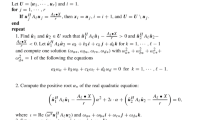Abstract
This paper introduces biquaternion eigen-decomposition theory (via Peirce decomposition) with respect to a selected quaternion with a non-zero vector part. The eigen-decomposition allows evaluation of polynomials and power series with real coefficients as functions of quaternions. This extension of analytic functions to functions of quaternions requires only standard complex function evaluation. The theory also applies to quaternion rotations. The theory uses biquaternion calculations indicated by matrix methods via the algebraic isomorphism between Hamilton’s biquaternions and appropriate \(4\times 4\) complex matrices. The isomorphism preserves algebraic structure. In particular, the left and right biquaternion multiplication by the selected quaternion maps to left and right matrix multiplication, respectively. This unifies the representation of the left and right quaternion multiplication as a linear map into a single matrix form. This matrix, as a linear operator, acts on matrices, so that the eigenvectors have matrix form that maps into the biquaternions. Use of an alternate quaternion basis results in a similarity transform of the representation matrix, preserving eigenvalues across change of basis. The similarity transform allows simple eigenvector calculation. The matrix for the selected quaternion has two identical, complex conjugate pairs of eigenvalues. Each pair corresponds to two complex conjugate pairs of eigenvector biquaternions, an idempotent pair and a nilpotent pair. Idempotent and nilpotent eigenvectors correspond to the commuting and non-commuting parts, respectively, of quaternion multiplication.
Similar content being viewed by others
References
Apostol, T.M.: Calculus, vol. II, 2nd edn. Wiley, Hoboken (1969)
Baek, J., Jeon, H., Kim, G., Han, S.: Visualizing quaternion multiplication. IEEE Access 5, 8948–8955 (2017). https://doi.org/10.1109/ACCESS.2017.2705196
Campos, H.M., Kravchenko, V.V.: Fundamentals of bicomplex pseudoanalytic function theory: Cauchy integral formulas, negative formal powers and schrödinger equations with complex coefficients. Complex Anal. Oper. Theory 7(2), 485–518 (2013)
Ell, T.A., Le Bihan, N., Sangwine, S.J.: Quaternion Fourier Transforms for Signal and Image Processing. Wiley, Hoboken (2014)
Flaut, C., Shpakivskyi, V.: Real matrix representations for the complex quaternions. Adv. Appl. Clifford Algebras 23(3), 657–671 (2013)
Francis, M.R., Kosowsky A, A.: The construction of spinors in geometric algebra. Ann. Phys. 317(2), 383–409 (2005)
Futagawa, M.: On the theory of functions of a quaternary variable (Part II). Tohoku Math. J. 35, 69–120 (1928)
Groß, J., Trenkler, G., Troschke, S.-O.: Quaternions: further contributions to a matrix oriented approach. Linear Algebra Appl. 326, 205–213 (2001)
Imaeda, K.: A new formulation of classical electrodynamics. Il Nuovo Cimento B (1971-1996) 32(1), 138–162 (1976)
Kuipers, J.B.: Quaternions and Rotation Sequences. Princeton University Press, Princeton (2002)
Lounesto, P.: Clifford Algebras and Spinors, vol. 286. Cambridge University Press, Cambridge (2001)
Luna-Elizarraras, M., Shapiro, M., Struppa, D., Vajiac, A.: Bicomplex numbers and their elementary functions. Cubo (Temuco) 14(2), 61–80 (2012)
Peirce, B.: Linear associative algebra. Am. J. Math. 4(1), 97–229 (1881)
Riley, J.D.: Contributions to the theory of functions of a bicomplex variable. Tohoku Mathematical J. 5(2), 132–165 (1953)
Ringleb, F.: Beiträge zur funktionentheorie in hyperkomplexen systemen I. Rendiconti del Circolo Matematico di Palermo (1884-1940) 57(1), 311–340 (1933)
Rodman, L.: Topics in quaternion linear algebra. Princeton University Press, Princeton (2014)
Sangwine, S.J.: Biquaternion (complexified quaternion) roots of - 1. Adv. Appl. Clifford Algebras 16(1), 63–68 (2006)
Sangwine, S.J., Ell, T.A., Le Bihan, N.: Fundamental representations and algebraic properties of biquaternions or complexified quaternions. Adv. Appl. Clifford Algebras 21(3), 607–636 (2011)
Skornyakov, L.: Encyclopedia of mathematics: peirce decomposition (2011) [cited July 15, 2018]. URL http://www.encyclopediaofmath.org/index.php?title=Peirce_ decomposition&oldid=15535
Tian, Y.: Matrix theory over the complex quaternion algebra, arXiv preprint math/0004005
Acknowledgements
This research is sponsored by the Office of Naval Research.
Author information
Authors and Affiliations
Corresponding author
Additional information
Communicated by Eckhard Hitzer.
Rights and permissions
About this article
Cite this article
Oba, R.M. Eigen-Decomposition of Quaternions. Adv. Appl. Clifford Algebras 28, 94 (2018). https://doi.org/10.1007/s00006-018-0911-6
Received:
Accepted:
Published:
DOI: https://doi.org/10.1007/s00006-018-0911-6



